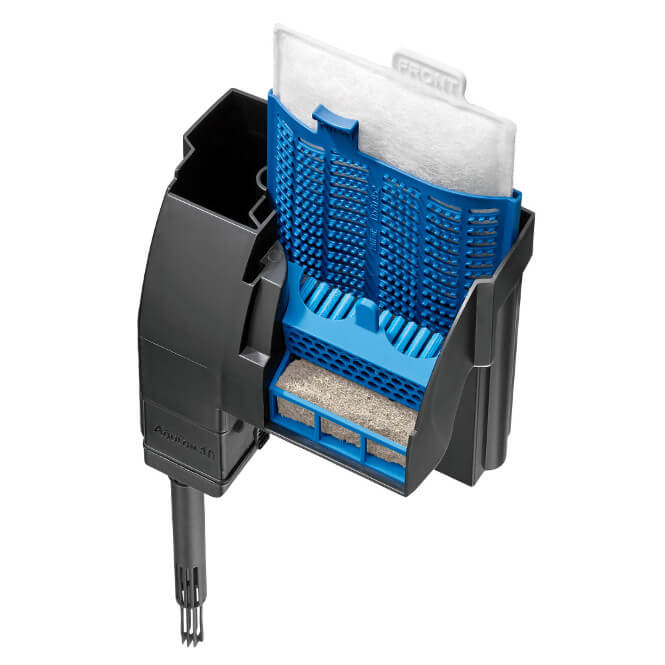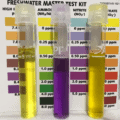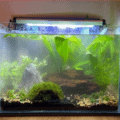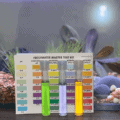Aquarium filtration may turn out noisy if you’re not familiar with the right equipment. A silent external fish tank filter does exist and, in fact, there’s more than one.

What about internal filters? Are they worth it? By the way, can you make an old aquarium filter quieter on your own? Is your current one really to be thrown away just because it’s too loud?
The Top 7 Quietest Aquarium Filters
A quick comparison table of the aquarium filters being reviewed in this article:
| Filter Model: | Noise Produced: | Additional Tech Features: | Price Bracket: | Water Turnover in Gallons / Liters: |
|---|---|---|---|---|
| 1. Eheim Classic 22(xx) Filter | – | + | $$ | 79 to 264 gal / 227 to 1000 liters (pump power, not Flow rate) |
| 2. Penn Plax Cascade (xxxx) Series | – | +++ | $$ | 115 to 350 gal / 435 to 1325 liters |
| 3. MarineLand Penguin (xxx) Power Filter | + | + | $ | 150 to 350 gal / 567 to 1325 liters |
| 4. Fluval (X)07 Series External Filter | – | +++ | $$$ | 145 to 383 gal / 550 to 1450 liters |
| 5. Eheim Professional 4+ Series | – | +++ | $$$$ | 250 to 330 gal / 950 to 1250 liters (pump power, not flow rate) |
| 6. SunSun HW-(xxx) Series External Canister Filters | – | ++ | $$ | 264 to 525 gal / 1000 to 1990 liters |
| 7. Aqueon QuietFlow LED PRO | + | +++ | $ | 100 to 400 gal / 380 to 1515 liters |
What’s the quietest type of aquarium filter?
There are a couple of different types of aquarium filters. They differ in the way they’re implementing the filtering technology. Here’s a list:
- Sponge filters
- HOB (Hang On the Back) filters
- Canister filters
- Internal filters
And here’s which type is the quietest:
Canister filters are hands-down the most silently-operating water filters for aquariums out there. Their architecture and the particular way of turning water via tubing allow them to remain absolutely soundless, while still performing the best in terms of water turnover.
Let me explain.
Sponge filters:
A sponge filter is technically a type of internal filter that’s powered by an air pump. The pump will create air bubbles that will quickly find their way to the top of water. This creates a bubbling noise.
I find that type of noise quite tranquilizing, but I can’t say it’s quiet.
These filters are usually used as secondary filtration for smaller tanks. The main reasons fishkeepers would get them are because of the extra oxygenation (as they move the water surface) and their potential to house beneficial bacteria.
Hang-on-back external filters:
A HOB filter’s motor will run very quiet indeed. However, the way they return water to your fish tank can be noisy.
They literally hang on the wall of your aquarium, creating a waterfall effect.
Many aquarists are not as diligent though. One needs to top off the water every 3 to 4 days, to avoid the splashing sound effect.
Most nowadays HOBs have slightly modified outlets that make the water “slide” in the tank rather than fall.
Still, evaporation eventually comes into play and you still find yourself enjoying the blessing sounds of Niagara Falls.
I personally am a big fan of white noise, and if you’re like me you’d probably appreciate a HOB filter.
However, if you have a roommate who’s a light sleeper, or the aquarium is situated in your children’s room I would not recommend this type of filter unless you’re willing to stay on top of the maintenance.
For diligent people only!
Internal filters:
Internal filters do actually perform well when it comes to noise.
But that’s about it.
It’s just that I would never recommend any of these filters to anyone.
They are air-powered (same as sponge filters), which makes them weaker. Unlike sponge filters however, their design makes them inefficient because they can’t use a lot of filter media and look overall ugly in your tank. Sponge filters at least are almost 100% filter media (the sponge itself). On top of all that, the internal filters break often and do not provide a filtration powerful enough.
Don’t compromise with your filtration, people!
These filters are not a good long-term investment, as you’d find yourself paying for a new one over and over again.
These filters only work for a smaller tank with very few fish in it. Like a small school of danios or some other dwarf fish.
If this is the case for you, you can look around in Amazon or Chewy for the Aqueon Quietflow Internal Filter.
Quiet but not good for a community tank.
External canister filters:
Canister filters crush the competition when it comes to soundproof filtration.
This is because they operate in a specially designed cartridge outside of the aquarium.
They are water-powered, which contributes to less internal noise.
Also, there’s tubing.
You won’t hear water splashing, because the water is being returned via a tube. This way they still move the water surface (providing oxygenation) while avoiding the crashing waterfall effect.
Most newer models have sound-dampening technology implemented to reduce the noise even more.
No vibration and no humming noises.
My experience has been that canister filters provide both the quietest and most powerful filtration.
My Reviews of the 7 Quietest Fish Tank Filters

The aquarium filter manufacturers would usually rate the loudness of their product in decibels and announce that on the box. However, these are never realistic, so I wanted to speak from my personal experience here. Here are the aquarium filters that are currently the quietest:
1. Eheim Classic Canister Filter Series

Click to compare pricing + see MORE photos of this product at:
It has been my experience that the Eheim is currently manufacturing the quietest aquarium filters on the market.
A long time ago, when I first installed my Eheim 2213 (Classic 250) I actually had to double-check if it worked.
The reason being it got completely silent after the initial priming.
The only way I could tell it was working was by placing my hand on it.
A slight vibration would indicate that the motor is pumping. This vibration could only be felt though, no humming sounds whatsoever.
This was a complete shock to me because back then I was really used to background noise from aquarium filters, at the least.
It was then when I converted to canister filters for life.
I already knew these types of filters have superior filtration and durability.
However, I did not expect a complete lack of noise.
This filter is no longer mine, it now runs at a friend’s house, because I moved to larger aquariums.
The models for a bigger fish tank would be the Eheim 2215 and 2217.
I used the 2213 model on my 20-gallon tank, and I will give you my personal recommendations for every tank size and setup, but more on that below.
Anyway, that happened many years ago.
When you buy an Eheim canister filter you just know that it will serve you for years to come.
These models are not new – the brand successfully sells them for the past 20 years, unchanged.
You know why?
Because they work and have been working for years.
Whatever model of Eheim canister filter you decide on, be sure that it will last.
I now run the stronger Eheim models at home and they still are virtually silent.
I am not really sure how they managed to pull that one-off, as it’s water movement we’re talking about here.
This includes motors, impellers, and other moving parts, so it’s kind of a mystery to me.
I do run other brands of canister filters too (as they all have their pros and cons for a certain setup) but when it comes to being quiet nothing beats my Eheims.
Note: Don’t get me wrong – ANY canister filter is designed to operate quietly and they do, compared to other types of filters. It’s just that the Eheim is the quietest among the quiet ones.
I know the subject here is loudness, but these filters are among my personal choices for the best filter overall.
Extremely reliable and easy to maintain.
You only need to clean the stuff every 2 to 3 months.
The tubing has valves on both ends, which makes the need to transport the unit upon cleaning to your bathroom unnecessary.
A con I would like to mention is the instructions. Pretty crappy instructions from such a giant in the industry.
Still, you can simply watch a video on Youtube on how the set up the thing. There are a plethora of those.
Below in this article, you can find a link to my full review of this product (not only concerning loudness).
2. Penn Plax Cascade (xxxx) Series

Click to compare pricing + see MORE photos of this product at:
The Penn Plax Cascade is one canister filter that really impressed me with its lack of operating sound.
They’re the top-selling aquarium canister filters on Chewy and Amazon, for a reason.
I currently run two of those on my larger tanks, both being the 1500 Series.
They run completely stealthy.
If this is their most powerful unit and it runs like that, I can’t imagine how quiet the smaller ones are.
Mine does give off a low hum when I stick my face inches away from the cartridges though. But with a closed cabinet, I can’t hear a thing.
It’s probably worth noting that I’ve read of people complaining about these filters being somewhat loud.
I do not have such an issue, so I’m assuming those are caused by human error. Or incomplete priming, which may or may not take a couple of days.
As with all canisters on this list, I can confirm that the Penn Plax is a nice fit for an aquarium that’s in a bedroom.
I do not currently keep mine in the bedroom as I now have a separate room for my aquariums, but long ago I used to.
Anyhow, discovering that this brand of canister filters is silent was by accident.
It had nothing to do with my initial purchase.
I actually got my first Cascade, because of the promising reviews and the huge filtration potential.
The Cascades come at a reasonable price for a canister filter, while being an authority on the market.
I could guess that the silent motor has something to do with that, but I’m sure it’s not the only factor.
These units are super customizable.
They move a lot of water and do come across as strong.
Still, the adjustable flow rate feature is something that I value when I’m choosing filters for my fish tanks.
Another customizable feature would be the valves. They rotate at 360 degrees. This provides plenty of flexibility when it comes to positioning the unit.
These filters are well-suited for larger aquariums with long-finned fish in it.
The kit comes with a spray bar, which I think is a must on a canister. The spray bar breaks down the stream, lowering the return pipe pressure. This way your fish won’t get blown around in the aquarium.
The Cascade series from Penn Plax are advertised to pump up to 350 gallons per hour. The 1500 one can absolutely handle one medium-to-highly stocked 55-gallon tank with predatory fish in it.
Even the rather messy cichlids.
If you plan on intentionally overstocking, I will suggest more suitable options, but more on that below.
If this filter starts to make a noise of some sort – it probably has air trapped inside.
Good thing these have their own self-priming buttons installed.
Push it a couple of times (note that it needs a strong push) and be done with the noise.
I think it should be mentioned that during the initial priming these are louder than the other canister models listed here. So don’t panic if the filter’s humming at first. It will likely pass in a matter of hours.
If you’re worried about your first night of sleep after the installation – install the unit early morning. This way by the time the evening comes, it should’ve primed itself fully.
Anyway, my experience has been that the Penn Plax Cascade is an excellent filter, that pumps thousands of gallons per day in complete silence.
I am really happy with mine, so I can wholeheartedly recommend it.
3. MarineLand Penguin (xxx) Power Filter

Click to compare pricing + see MORE photos of this product at:
…Where “(xxx)” stands for either 100, 150, 200 or 350.
I am listing this along with one more HOB filter here for two reasons: affordability and proper way of use.
In general “hang on back” filters are inexpensive compared to a canister one.
With a canister filter, you pay for stronger filtration, durability, and silence.
Still, HOB filters should not be underestimated as they are perfect for small fish tanks that are not overstocked (though we all end up overstocking at some point…).
Case in point, the MarineLand Penguin 75 is likely the best and most silent filter you can get for your 10-gallon fish tank.
By approaching the maintenance properly you will still end up with a quiet fish tank filtration.
So here’s the thing:
This filter’s motor is as silent as a canister’s one.
No, really, it is.
Your only concern in terms of loudness would be the sound of splashing water.
Some people are bugged by the humming noises and others by the splashing.
In my observations, the MarineLand Penguin has no humming noise whatsoever.
And I could easily overcome the splashing.
The only thing I’d need to do is regularly top off the water in the aquarium. This would occur every 3 to 4 days, depending on the season. In the summer the water would evaporate faster.
When topping off, I was making sure the surface reached the outlet of the filter. This way the incoming water was perfectly connected to the surface, eliminating any bubbling noises.
Whenever the water was at a reasonable level, the filter would run completely silent.
It’s a powerful filter and it could handle my 30-gallon community tank.
I think the tank was stocked at around 70%, from what I can remember.
I now run such one filter (the 350) as a secondary filtration on my 55-gallon predatory tank, where I house my smaller Oscars. Very messy fish, if you’re familiar with them.
Anyway, when installing this filter, make sure it does not touch the wall of your room. This will make the vibrations noticeable and you will be able to hear them.
Other than that the MarineLand brand is an authority in the HOB industry.
And that was proclaimed by us, the users.
If you decide on this filter, know that the maintenance will be a breeze.
Easy to clean and easy to change the media.
It’s a pretty good deal for the price tag that comes with it.
Opt for a filter that will turn the water in your tank at least 8 to 10 times per hour. This means that if you want to reasonably stock a 30-gallon fish tank, you should probably get the MarineLand Penguin 350.
Do the calculations for smaller tanks.
Note that with canister filters this estimated number is lower.
These filters come with numerous filter media trays.
The 350 comes with 4.
You can essentially experiment with whatever pads you want.
As for loudness, this filter is perfect if you’re on a tighter budget and you’re willing to maintain a constant water level in the aquarium.
4. Fuval (x)07 External Canister Filters

Click here to see the current price on Amazon.
In my heart, Fluval is the brand that fights Eheim to win me over on the best possible aquarium filtration overall.
Loudness included.
In my personal experience, the Fluval 07 external canister filter series that came out the past year are the second-best performer in terms of quietness.
The 06 Series is what I’d recommend before the 07 came out.
These units have their own patented technology for sound-dampening the motor.
They are, again, virtually silent.
Why did I place them second?
Because you can hear them working if you stick your head inside the aquarium stand where you house them.
Considering your head won’t spend much time there, I would say these filters are a pretty decent choice for light sleepers or people who are easily irritated by background noises.
If you find yourself browsing Youtube reviews of this filter just to hear the sound it makes, stop right there!
Did you notice something in common between all these videos? That’s right, these are all made right after the filter has been set up.
A canister filter will be louder right after the installation.
This is because of the small air bubbles inside. Priming is what this is about – extracting air from the cartridge.
However, a small portion of microscopic bubbles remains, before the filter establishes itself.
The remanent priming will take care of the air in the next couple of days (3 to 4) after the installation.
It’s a natural process and it will happen on its own.
But at this point, the filter will be slightly louder.
Some canister filters are faster in the remanent priming than others.
The Fluval 07 filter is, again, the second-best here. Why would you go for a Fluval you may ask?
Well, because it’s still ultra-silent overall and because of your… fish tank’s size.
The Fluval 107, 207, 307, and 407 all offer more GPH (gallons per hour) than the aforementioned Eheim models, judging by the difference in reported pump performance.
If you’re planning to set up a 55-gallon tank with, I’m assuming, lots of waste producers such as cichlids or other carnivorous medium-sized fish, you need plenty of filtration.
Going with the 307 or (preferably) the 407 here would be wise. But more on my tank-size filter recommendations below.
With its sound-dampening feature and the soundproof cartridge, the Fluval 07 external canister filter is a top choice for a quiet filtration of heavily stocked middle-sized aquariums.
It is very durable and it will probably last for 5 or more years, based on my experience with the 06 Series.
My 306 is currently hitting 8 years and it still runs like a champ.
Anyway, with these aquarium filters, you have the added benefit of huge media trays for your filter media of choice.
They are also equipped with Aquastop valves that, eliminate leaking during maintenance.
Oh, by the way, the maintenance is easy as well. The instructions for disassembly are written all over the cartridge.
Th Fluval 07 Seris canister filters are excellent for people who want silent filtration for their medium-size aquarium with messy fish such as cichlids or Oscars.
I also recommend considering this brand if you’re picking turtle tank filters.
5. Eheim Professional 4+ Series

Click here to see the current price on Amazon.
Noiseless work is actually the first thing you will probably notice when you first plug in the Eheim Professional 4+.
My friends who own this canister filter consider its quietness as some of its top qualities alongside flawless filtration.
In fact, the Eheim Professional 4+ is so silent that, in most cases, you don’t really need to put it inside a cabinet to mute any perceived humming.
You’d want this level of ninja aquarium filtration if you’re extremely sensitive to noise.
Ok, that’s nice and all but, as you can see, the price of this filter is in the upper bracket. So what else is really in it? To summarize my observations and not put you to sleep with boring descriptions:
- It has tons of space for filter media which is what you’d want if you plan to overstock your aquarium.
- Because of the large cartridge the filter needs cleaning pretty much once a year.
- Doesn’t bump up the electricity bills.
- Priming is not the easiest but nothing that takes away from this filter’s overall good score.
- Insanely sturdy and long-lasting.
So if you have something like a 55-gallon tank with plenty of cool but messy fish and budget is not your concern the Eheim Professional 4+ might be the best among the quietest filters for you.
6. SunSun HW / Polar Aurora External Canister Filters

Click to compare pricing + see MORE photos of this product at:
The SunSun / Polar Aurora canister filters come from China and are fairly cheap for the filtration power they provide.
They have really strong motors and can pump lots of water. Needless to say, as a self-respecting hobbyist, I was obligated to buy and try one for myself.
I’m glad that I did.
The huge added kit value aside, these filters do excellent filtration, while running absolutely stealthy.
After the initial priming is done there was slight background noise in the form of a gentle hum. But as soon as I closed the doors of the cabinet where I kept the filter it was gone.
Fast forward 2 or 3 days in, the filter became completely silent, which I would assume has to do with the remanent priming.
From all of the units on this list, I’d rank this filter right along with the Fluval 07 Series, sharing second place. But that’s only upon proper use and after the remanent priming has taken place.
Remember that all canister filters have this period when you first plug them in.
Having said that let’s discuss the filter itself.
This is probably the only device on this list with such added kit value (which is not the same as tech features!).
By that, I mean that in the box you’ll also get 6 filter pads, active carbon media, 2 different types of bio-media, and a UV sterilizer. Holy smokes!
Though if you need a UV sterilizer I’d recommend getting one of the better standalone ones, these filters are great for people on a budget.
Now, look the filter up on either Chewy.com or Amazon.com and check the price.
Can you believe that?
In terms of price to value, the SunSun canister filters are really killing it.
However there are cons, and I would like to mention as well:
Well…it’s cheaper equipment.
Nothing wrong with that, just don’t expect this filter to outlive an Eheim or a Fluval.
These are not a years-to-come solution for your aquarium filtration. The warranty is rather short (a couple of months).
With proper maintenance, I’ve had mine live for about 2.5 years, which is quite alright for a filter of this price.
Also, note that the promise of turning over 500 gallons of water per hour is not realistic.
Don’t get me wrong, it’s really going strong and it can cap at around 300 with less livestock. Which is more than enough for me to run a SunSun as additional filtration to 2 of my larger fish tanks that hold over 100 gallons of aquarium water.
Bear with me, later in this article, I will point you out which canister filter is the best for your tank’s size.
Another thing I would consider more or less a con is the instructions.
Pretty crappy English translations, but the internet is full of guidance on how to properly set up the stuff.
Still, this very silent canister filter should not be overlooked. If you’re concerned about sound and have a tighter budget to support a 55 to 75-gallon fish tank that’s not overstocked – consider getting this, please.
I recommend.
7. Aqueon QuietFlow LED PRO

Click to compare pricing + see MORE photos of this product at:
Don’t mistake this filter for its internal counterpart the “QuietFlow E”.
I am sticking to my words and I’ll only recommend external HOBs or canisters that are actually worth having.
These units come in 5 different sizes as follows: 100, 125, 200, 250, and 400 GPH.
Naturally, the higher you go the larger the aquarium you’d want to filter.
For a decent filtration, you should seek around 10 times water turnover for your tank.
But more on that below in this article. Now, let’s talk loudness.
From my experience, you should only get this filter if you have a smaller tank, nothing above 20 gallons.
Why?
The more powerful the units get – the louder they become.
If you get the 400 GPH version and are irritated by humming noises, you better have your aquarium in your basement.
Don’t get discouraged though.
This filter is a decent option for a 10 to 20-gallon fish tank.
The smaller units pump lots of water while being quite affordable and very quiet.
The motor of this filter should be submerged which does dampen down the sound.
Again, being consistent with the water top-offs is a must if you hate the sound of crashing water.
I think the smaller Aqueon units have a quieter motor than their AquaClear counterparts if I was to compare motor loudness alone.
Perhaps, there’s a reason to include that in the model’s name?
Still, going for a stronger Aqueon may not be a good idea if you’re a light sleeper.
Actually, that applies universally to every fish tank. If you have a larger one and want it to be as quiet as possible, you should absolutely aim for a canister filter. But if you’re newer to the hobby and want to filter, say, a small bowfront fish tank without breaking the bank – purchase an Aqueon QuietFlow LED PRO and be done with it.
Top off the water in the tank every 3 to 4 days and enjoy the silence of these.
For a 10 gallon tank, I suggest that you get the Aqueon 20 (the one that’s rated for up to 30 gallons). Reason being that employing media and the fish stock will lower the final flow rate of the unit.
Don’t forget that it’s still a HOB filter and a canister one would work dead silent compared to those.
Still, in my opinion, this is the quietest external power filter out there, so long as you adhere to the rules I mentioned above.
Which one should you pick for your tank’s size?
There are tons of possible aquarium setups, and you should really take into account yours when picking a filter. I’d need to write a whole separate article to realistically cover all of them. Well, in fact, I did:
Since silence is what we’re after here, the article is about canister filters only, with them being the quietest type of filter out there.
It took me quite some time to put it together, so please do check my canister filter guide on aquarium sizes. Click the link to find your info.
When you enter the first page you’ll first see a quick navigation table there. Find your desired aquarium size in it and click on its respective link. This will scroll down the article to exactly where I discuss all possible setups for this tank’s dimensions. I’ve listed all the sizes – from 10 to 125+ gallon fish tanks.
You can also skim through my full reviews on all the canister models that I’ve listed here.
Since there’s nothing on HOB filters there I would like to give you a quick recommendation here:
With HOBs you aim at having your water turned at least 10 times per hour. With canisters you want that to be 6 to 8 times, depending on your livestock. When picking your filter consider these:
- Carnivorous fish make a lot more mess
- Goldfish are the equivalent of pigs in the fishkeeping world
- Long-finned fish species such as the Betta fish can get exhausted from swimming in a stronger filter current
- If you plan to intentionally overstock your tank, go for the highest water turnover possible
- Fry (baby fish) may get sucked in a stronger filter, so have a separate tank for those prepared
- Stages of filtration and the space for filter media
How to silence a fish tank filter that’s already running?
If you already have a filter that is being too loud, you should try everything you can before buying a new one, right? Here’s a list of things that can quiet a noisy fish tank filter:
- Remove the ceramic and bio balls media – In filters with stronger pumps, the vibration noise could easily be multiplied by ceramic bio-balls. This is something I discovered on my own. Not really proud, but it’s worth mentioning!
- Use filter floss – aside from polishing your water crystal clear, filter floss can also reduce the inside noise of your filter. I wrote an article on where to get tons of it for really cheap and why you should use it.
- Top off the water level consistently – If it’s a HOB filter you’re having you might be familiar with the waterfall bubbling noise. To achieve a silent aquarium overflow, just top off the water that has been evaporating. The closer the water surface is to the filter outlet, the less splashing there will be. This will effectively put an end to your fish tank filter’s noisy bubbles. If it’s a turtle tank that you’re having, have a look at this video.
- Wait out the remanent priming – Did you recently install your filter? Is it a canister filter? If this is the case then there might be some remanent priming going on. After the initial priming, some microscopic air bubbles might still remain inside of your filter. Worry not – the device will sort that on its own. Just give it some more time. Manually joggle the unit if needed.
- Remove gunk trapped inside – though kind of obvious when it comes to noise reduction, it’s mandatory to mention this. If there’s gunk or sand trapped on the inside of your filter it may be the cause behind the rattling.
- Apply vaseline to the impeller – an old trick that you should definitely try before rushing to the store for a new unit. Use a cotton swab and apply liberal amounts on the impeller of your filter. There are tons of videos online on how to disassemble one if you’re worried you’re not handy enough.
- Replace the faulty part – well, all things break eventually. You should at least manually inspect the insides of your filter before throwing it away. An unnatural grinding noise is usually caused by a faulty motor or impeller. After you identify the faulty piece, look up its replacement, and see if it’s worth the hassle. Usually, the parts can be found cheaper online, if you’re willing to wait for the delivery. If you have friends who are also fishkeepers, there may be a good chance that they’ll have what you need, so ask around.
- Clean the pipes and tubing – sometimes debris may partially clog the tubing, which leads to a louder hum in stronger aquarium filters. Use hot water to rinse the insides. Don’t forget to run some dechlorinated water through them after the cleaning.
FAQs
What is the quietest type?
Generally, speaking canister filters are the quietest type of aquarium filter. Their inlet and outlet remain underwater and the canister itself can be stored in a cabinet which further reduces the noise it makes.
Hang-On-Back filters usually produce a splashing noise because of their waterfall-like design. Sponge filters hum because their pump always creates bubbles.
How to make my fish tank quieter?
One thing you can do to make your aquarium quieter would be to change your HOB or sponge filter to a canister one. Another thing can be to buy high-end equipment in general. The manufacturers of high-end equipment typically take noise into account when building their products.
Does a noisy one bother pet fish?
The only thing that bothers pet fish is the lack of food and bad water parameters in the tank.
Anything else in their aquarium is just part of their environment as far as they’re concerned.
Noisy filters cause some vibrations to the water but this is not something harmful or annoying for pet fish.
What is the easiest to maintain?
Canister filters are larger than HOB and sponge filters, and so need maintenance every couple of month.
This is because it takes a lot of time for them to get dirty. Smaller filters like the HOB and sponge ones require less work each cleaning session but need more frequent cleaning sessions to remain efficient.
The sound conclusion
Choosing an aquarium filter that remains quiet can be challenging without a helpful review from a fellow fishkeeper.
I did my best to outline what I like and dislike about all the units that I’ve included on my list.
My top choice remains the Eheim Classic canister filter. I would personally rate them best when it comes to being silent.
Share with me your thoughts and experiences in the comments and I’ll get back to you as soon as I see them.











38 thoughts on “Discover the 7 QUIETEST Aquarium Filters: Loudness Reviews (2024)”